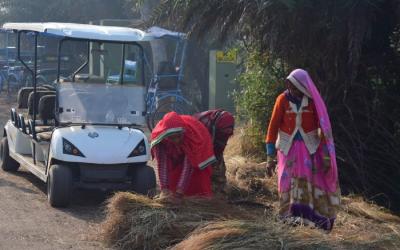Members of the Koya tribe inhabiting the foothills of the northern Eastern Ghats in Andhra Pradesh are worried. Their lives have been in disarray since India’s nationwide lockdown began on March 24. The government has restricted their movement through the forests, leaving them completely reliant on a few grocery stores in nearby towns, which open only for a few hours every day. Their incomes have also been plummeting, and they are often at the mercy of government agencies, and a few compassionate law-enforcement officials, for their staple foods.
The Koya and Konda Reddi are the two largest tribal groups in the northern Eastern Ghats of Andhra Pradesh. Other tribes include the Nayakpod, Khond, Gadaba, Bagatha, Savara and Paraja. The northern Eastern Ghats is contiguous with the Dandakaranya region in the west, a thickly forested plateau covering the Bastar region of Chhattisgarh and parts of Andhra Pradesh, Telangana and Maharashtra. A large number of the Maria Gond (Gutti Koya in Andhra), displaced from Chhattisgarh over the last two decades due to armed conflict, also inhabit the northern Eastern Ghats.
These communities have lifestyles linked strongly to forests, sustaining themselves primarily through minor forest produce collection, shifting cultivation and seasonal employment in farms. More recently, they have also been forced to seek work in forest plantations and make occasional hunting forays. However, all these livelihood activities have come to an abrupt halt as entry into forests or movement outside villages has been prohibited.
As nations around the world grapple with the health, environmental and economic repercussions of the coronavirus pandemic, we take a bird’s eye view of how the pandemic has affected India’s forest-dwelling tribal communities.
A large number of tribal groups (Scheduled Tribes) live in the northeast, and across large swathes of Chhattisgarh, Odisha, Jharkhand, Madhya Pradesh, Maharashtra, Andhra Pradesh, Karnataka and Tamil Nadu. Most of the districts they live in are characterised by isolation, economic backwardness and poor infrastructure – and significantly more forest cover. Although the prevalence of COVID-19 cases is lower in districts with a higher proportion of tribal communities, they have not been fully immune or left unaffected.
These communities earn their livelihood chiefly by collecting more than 15 different types of minor forest produce, including honey, gum, bamboo, beedi leaves, broomstick grass, tamarind and Indian gooseberries. All collections have now stopped. Disrupted movement and supply of essential commodities have also affected these communities.
In several protected areas, communities are prohibited from moving outside their villages following orders from the Union environment ministry, supposedly to ensure their safety. However, there has been little discussion on the lockdown’s impact on these communities.
In places like the Kalakkad Mundanthurai Tiger Reserve (KMTR), located in the southern Western Ghats of Tamil Nadu, the Kani tribal community that lives in just four settlements has found itself completely cut-off. The Kani historically inhabited the southern Western Ghats. Most of them were resettled in the plains outside the eastern boundary of KMTR when it was declared a tiger reserve in 1988. These four settlements host around 500 people, and are the only ones that remain within the reserve, albeit under the watchful eye of the forest department.
The National Tiger Conservation Authority has banned human movement inside all 50 tiger reserves following news that tigers could be infected by the novel coronavirus. Thus, the Kani have no means of communication or transport inside KMTR. Now, they depend entirely on the forest department for rations.
The Soliga of the Biligiri Ranganathaswamy Temple tiger reserve and the Male Mahadeshwara hills wildlife sanctuary in Karnataka’s Western Ghats have similar stories. The Soliga are spread around the central Western Ghats in BR hills and MM hills. They collect a range of non-timber forest produce, such as leafy vegetables and fruits, primarily during the monsoon and post-monsoon seasons. But during summers, between the months of February and April, the Soliga collect tubers and many wild fruits, both sources of nutrition, particularly in drought years. During the pandemic as well, these wild fruits have been a major food source for the Soliga. They collectively harvest these products and sell them to visitors to the Biligiri Ranganathaswamy Temple or to the cooperative Large-sized Adivasi Multipurpose Cooperative Societies.
Some also have direct access to urban and semi-urban markets through NGOs, and the tubers and fruits directly. Currently, the movement of the Soliga inside forests has been restricted, so their collection of other non-timber forest produce – especially antuvala (Sapindus emerginatus), arale (Terminalia chebula) and sege (Acacia concinna) – has been stalled. This in turn has drastically affected their long-term food security. They manage to get only rice from the government.
Communities living in some forest landscapes have been relatively less affected, such those in upper Assam’s Dehing Patkai Wildlife Sanctuary and surrounding forests, close to the town of Dibrugarh. This region is home to diverse communities, such as the Ahom, the Sonowal Kachari, the Muttak, the Moran, Nepali, the Chutia and the tea-tribe Adivasi from Jharkhand, brought here by the British as indentured labourers. Many of these communities depend on forests for firewood, cane, leafy vegetables, ferns, fruits like arale, otenga (Dillenia indica), edible mushrooms, etc. Access to forests also allowed them to fish in streams or hunt on occasion. They continue to collect what is available, using their proximity to towns to stay afloat.
Their use of forest products and movement in forests is likely to come under more scrutiny by overzealous governments attempting to prevent the spread of the virus. How will the lockdown and other measures affect them? Will these restrictions affect the implementation of the Forest Rights Act, already been impeded in several parts of the country? In the long run, could the lockdown in fact have been a blessing in disguise for our wildlife and forests? We can’t answer any of these questions now. Only time will tell. But until it does, we should remember that our forests aren’t just trees and tigers either.



